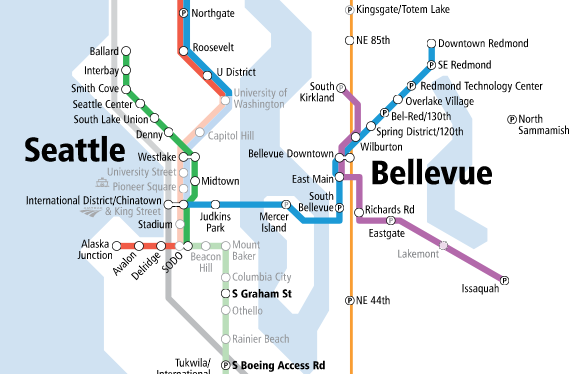
In 2016, voters in the Puget Sound region passed Sound Transit 3, a $54 billion package to build 62 new miles of light rail, create faster and more reliable Bus Rapid Transit, and expand Sounder train service. While we continue to celebrate this big transit win, we must remember that this new transit system isn’t built overnight.
After a ballot measure passes, it takes a huge amount of work to implement the project and ensure that stations and alignments maximize ridership and access for those that need it most, as well as support community needs and encourage equitable transit-oriented development near transit stations.
Which brings us to the project’s current phase: the system planning process. Your participation and input in this process can shape our transit system for generations!
Incorporating racial equity into the planning process
The light rail extension connecting West Seattle and Ballard to the larger system is happening now and Sound Transit is deciding where to build and connect stations in West Seattle, Ballard, SoDo, Chinatown International District, and Interbay. Sound Transit has received public input through an online survey and community forums and pulled together three groups to help provide strategic input throughout the project’s development: the Stakeholder Advisory Group of selected community members representing neighborhoods along the extensions; the Elected Leadership Group of Elected officials who represent the project corridor; and the Sound Transit Board that has the final vote on the preferred alternatives and oversees the entire project.
For the first time, Sound Transit is partnering with the City of Seattle to apply the city’s Racial Equity Toolkit (RET) to this project. Thus far, the RET has focused on identifying impacted communities, but has not made specific recommendations. Still, the use of the tool maintains pressure and emphasis on ensuring just outcomes for communities of color, especially the Chinatown-International District (CID). It’s important to deepen the application of this tool and using it to drive equitable outcomes. The CID has lived through a disproportionate share of construction and transportation impacts, and will likely continue to experience displacement as a result.
Stakeholders and electeds make the latest round of recommendations
With the help of the Stakeholder Advisory Group, Elected Leadership Group, and community input, Sound Transit has developed its first round of alternatives: routes, station locations, and other project elements. Check out all of the alternatives the groups were considering for West Seattle, Ballard, SoDo and the Chinatown International District, and Interbay.
Last Friday, October 5, the Elected Leadership Group looked at recommendations from the Stakeholder Advisory Group — plus comments from community groups, including TCC and the Transit Access Stakeholder coalition — narrowed down its preferred level two alternatives. Check out their decisions here. A final decision on the second round of alternatives will be made by the Sound Transit Board in early 2019.
See the Elected Leadership Group’s recommendations here.
Get ready for more public input
There is still time to help influence light rail routes, station locations, and other design and project elements!
The project has heard that the public is concerned with the long delivery date. To help expedite the light rail extensions, the current stage of the project is moving fast. The trade-off is that the window for public input and meaningful community engagement is short.
Once the abundant options for level two alignments are narrowed down in early 2019, the public will have a another opportunity to look through the final options and provide feedback. There will be more time to be engaged and less information to digest.
Stay tuned for regular updates from Transportation Choices on how you can stay involved in the light rail development process. In the meantime, check out the project overview and community participation portal to stay up to date on ways to get engaged.
Click here to check out the Transit Access Stakeholder coalition’s letter to the West Seattle and Ballard Link Extension Elected Leadership Group.




